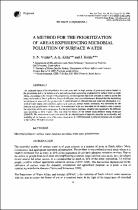 ResearchSpace
ResearchSpace
Method for the prioritization of areas experiencing microbial pollution of surface water
JavaScript is disabled for your browser. Some features of this site may not work without it.
- ResearchSpace
- →
- Research Publications/Outputs
- →
- Journal Articles
- →
- View Item
| dc.contributor.author |
Venter, SN

|
en_US |
| dc.contributor.author |
Kuhn, AL

|
en_US |
| dc.contributor.author |
Harris, J

|
en_US |
| dc.date.accessioned | 2007-03-26T08:55:37Z | en_US |
| dc.date.accessioned | 2007-06-07T10:02:01Z | |
| dc.date.available | 2007-03-26T08:55:37Z | en_US |
| dc.date.available | 2007-06-07T10:02:01Z | |
| dc.date.copyright | en_US | |
| dc.date.issued | 1998 | en_US |
| dc.identifier.citation | Venter, SN, Kuhn, AL and Harris, J. 1998. Method for the prioritization of areas experiencing microbial pollution of surface water. Water Science and Technology, vol. 38(12), pp 23-27 | en_US |
| dc.identifier.issn | 0273-1223 | en_US |
| dc.identifier.uri | http://hdl.handle.net/10204/2036 | en_US |
| dc.identifier.uri | http://hdl.handle.net/10204/2036 | |
| dc.description.abstract | The increased threat of faecal pollution in recent years and the high priority of protecting human health by the government led to the initiation of a national microbial monitoring programme for surface water in South Africa. According to the design of the programme, monitoring sites had to be selected in order to assess the status and trends of faecal pollution. Issues of efficiency and cost-effectiveness dictated that the monitoring would focus on areas with the greatest risk. A method based on relevant land and water use information (e.g. level of water supply and sanitation, agricultural practices, surface runoff, recreation) was developed for the selection and prioritization of these areas. A measurement scale was described for all sensitive uses to ensure the objectivity of the selection process. For the prioritization purposes, weights were assigned to the different uses according to their impact. This was done by means of the simple multi-attribute rating technique (SMART). The method was found to be useful for the identification of high-risk areas but the availability and reliability of the data are some of the major constraints. | en_US |
| dc.format.extent | 282572 bytes | en_US |
| dc.format.mimetype | application/pdf | en_US |
| dc.language.iso | en | en_US |
| dc.publisher | Pergamon-Elsevier Science Ltd | en_US |
| dc.rights | Copyright: 1998 Pergamon-Elsevier Science Ltd | en_US |
| dc.source | en_US | |
| dc.subject | Microbial pollution | en_US |
| dc.subject | Water uses | en_US |
| dc.subject | Surface water | en_US |
| dc.subject | Land use activities | en_US |
| dc.title | Method for the prioritization of areas experiencing microbial pollution of surface water | en_US |
| dc.type | Article | en_US |
| dc.identifier.apacitation | Venter, S., Kuhn, A., & Harris, J. (1998). Method for the prioritization of areas experiencing microbial pollution of surface water. http://hdl.handle.net/10204/2036 | en_ZA |
| dc.identifier.chicagocitation | Venter, SN, AL Kuhn, and J Harris "Method for the prioritization of areas experiencing microbial pollution of surface water." (1998) http://hdl.handle.net/10204/2036 | en_ZA |
| dc.identifier.vancouvercitation | Venter S, Kuhn A, Harris J. Method for the prioritization of areas experiencing microbial pollution of surface water. 1998; http://hdl.handle.net/10204/2036. | en_ZA |
| dc.identifier.ris | TY - Article AU - Venter, SN AU - Kuhn, AL AU - Harris, J AB - The increased threat of faecal pollution in recent years and the high priority of protecting human health by the government led to the initiation of a national microbial monitoring programme for surface water in South Africa. According to the design of the programme, monitoring sites had to be selected in order to assess the status and trends of faecal pollution. Issues of efficiency and cost-effectiveness dictated that the monitoring would focus on areas with the greatest risk. A method based on relevant land and water use information (e.g. level of water supply and sanitation, agricultural practices, surface runoff, recreation) was developed for the selection and prioritization of these areas. A measurement scale was described for all sensitive uses to ensure the objectivity of the selection process. For the prioritization purposes, weights were assigned to the different uses according to their impact. This was done by means of the simple multi-attribute rating technique (SMART). The method was found to be useful for the identification of high-risk areas but the availability and reliability of the data are some of the major constraints. DA - 1998 DB - ResearchSpace DP - CSIR KW - Microbial pollution KW - Water uses KW - Surface water KW - Land use activities LK - https://researchspace.csir.co.za PY - 1998 SM - 0273-1223 T1 - Method for the prioritization of areas experiencing microbial pollution of surface water TI - Method for the prioritization of areas experiencing microbial pollution of surface water UR - http://hdl.handle.net/10204/2036 ER - | en_ZA |





